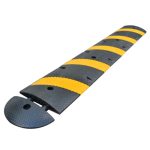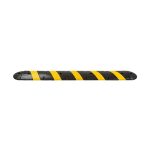Introduction
As our urban landscapes continue to evolve, the challenges of maintaining road safety and managing traffic become increasingly complex. This necessitates the search for innovative and effective solutions designed to mitigate the impact of fast-moving vehicles and enhance pedestrian safety. Among these solutions is the concept of traffic calming – a strategic approach aimed at reducing vehicle speeds and improving safety on our roads. This approach is manifested in various forms, one of which is the speed table – a midblock traffic calming device that is gaining significant attention for its effectiveness.
Speed tables, often confused with speed humps, are unique traffic calming structures designed to moderate the speed of vehicles. Unlike speed humps that are shorter and more abrupt, speed tables are longer and flat-topped, with a height of about 3–3.5 inches and a length of 22 feet. The primary purpose of a speed table is to raise the entire wheelbase of a vehicle, thereby reducing its speed. They effectively force drivers to slow down, making roads safer for both drivers and pedestrians.
The importance of speed tables in traffic calming cannot be overstated. The design and installation of speed tables have been associated with a decrease in traffic speeds, making roads safer for all users. Studies show that vehicle operating speeds on streets with speed tables range from 25–45 mph, depending on the spacing. This reduction in speed has been linked to fewer accidents and improved road safety.
In addition to reducing vehicle speeds, speed tables play a crucial role in shaping the dynamics of traffic on collector streets, transit, and emergency response routes. Speed tables are often designed as raised midblock crossings in conjunction with curb extensions. This design serves to further control the speed and flow of traffic, enhancing safety, and efficiency.
Although speed tables are usually accompanied by signage to warn drivers of their presence, they are often strategically placed in locations where drivers would naturally decelerate, such as near pedestrian crossings or blind turns. This integration of speed tables into the architecture of the road enhances their efficacy as traffic calming devices, while minimizing the disruption to the natural flow of traffic.
In conclusion, the introduction of speed tables as part of the traffic calming toolkit represents an adaptive response to the need for increased road safety. The unique design of speed tables – their length, height, and flat tops – makes them effective at reducing vehicle speeds, improving pedestrian safety, and facilitating better traffic management on busy roads. Their strategic placement and the accompanying signage further enhance their effectiveness, making them an important addition to our urban and suburban landscapes.
Impact of Speed Table Design
The design of speed tables plays a significant role in traffic calming and road safety. These typically flat-topped structures, raised to a height of 3–3.5 inches and extending over a length of 22 feet, are strategically placed midblock to effectively reduce the operating speed of vehicles. Depending on the spacing, the speed range for streets furnished with speed tables is usually between 25-45 mph.
It is crucial for speed tables to be accompanied by appropriate signage, such as the MUTCD W17-1, serving as a warning to drivers. Occasionally, where a speed hump has been configured as a crossing spot for pedestrians, a pedestrian sign (W11-2) may be used instead of a Speed Hump sign. Moreover, speed tables can be designed as raised midblock crossings, an approach often used in conjunction with curb extensions. This design not only serves to slow down traffic but also offers a safer crossing for pedestrians.
Advantages of Speed Tables
Speed tables are gradually gaining worldwide recognition for their vital role in road safety. Their principal advantage is their potential to reduce vehicle speeds. By raising an entire vehicle’s wheelbase, speed tables force drivers to slow down, curbing the tendency for speeding. This is particularly crucial in residential areas, near schools, and in other zones where high speeds pose significant risks to pedestrians and other road users. Evidence suggests that the presence of speed tables can reduce vehicle operating speeds to between 25 and 45 mph, which significantly cuts the chances of severe accidents.
Another advantage of speed tables is improved safety for pedestrians. The design of speed tables often includes raised midblock crossings. These crossings serve as a designated area for pedestrians to cross, increasing their visibility to oncoming traffic. Importantly, speed tables give pedestrians the confidence that vehicles will be moving at a reduced speed when they are crossing. This aspect is particularly vital in areas heavily frequented by children, the elderly, or people with mobility issues.
In addition to their critical role in pedestrian safety, speed tables can also contribute to improved response times for emergency vehicles. Unlike speed humps, which can delay these vehicles, speed tables are long enough to allow for smoother transitions at higher speeds. Therefore, emergency response vehicles like ambulances and fire trucks can maintain a higher rate of speed without compromising safety. This aspect allows for faster response times in situations where every second counts.
Moreover, speed tables can also promote safer driving habits. By forcing drivers to slow down, these traffic calming devices can help foster a culture of responsible driving. Over time, drivers who regularly encounter speed tables may become more accustomed to driving at lower speeds, even in areas without such devices. Hence, speed tables can have a positive psychological effect on drivers, indirectly contributing to road safety.
Furthermore, the use of speed tables can also enhance the aesthetics of a neighborhood. They can be designed with various materials and colors, contributing to a neighborhood’s identity and sense of place. They can also be integrated with other street improvements like bike lanes, pedestrian plazas, or green infrastructure, enhancing the overall street design and user experience.
In conclusion, the potential benefits of speed tables are impressive, ranging from reduced vehicle speeds to improved pedestrian safety and quicker emergency response times. They can also foster safer driving habits and contribute to neighborhood aesthetics. Although they present some challenges, the advantages they offer make them an essential component of modern road safety strategies.
Disadvantages of Speed Tables
While speed tables serve an essential role in traffic calming and safety enhancement, it’s equally important to acknowledge certain disadvantages that accompany their use. One prevalent downside is the potential increase in noise pollution. As vehicles pass over these devices, especially at higher speeds, they may generate significant noise, which can be disruptive for residential areas, particularly during the night.
Additionally, the design of speed tables can pose challenges for larger trucks. Their length and height may limit the maneuverability of these vehicles, thereby impairing the smooth flow of traffic. This could lead to unexpected delays in delivery schedules and overall traffic congestion. It’s also essential to note that their presence can inadvertently restrict the overall traffic flow, especially if they are improperly or excessively installed. Therefore, despite their numerous benefits, these possible implications should be considered during speed table planning and design.
Conclusion
Drawing to a close, our discourse on the impact and design of speed tables as traffic calming devices provides us with substantial evidence of their significance in road safety. Our exploration spanned from their definition to their prominent influence on vehicle speeds, the essential signage requirements, and the design of raised midblock crossings. Speed tables, with their 3-3.5 inch height and 22 feet length, have proven to be effective in slowing down vehicles, thereby fostering safer road conditions.
Undeniably, the benefits of implementing speed tables are manifold. Most prominently, speed tables contribute to the reduction of vehicle speeds, making streets safer for both drivers and pedestrians. The design of these traffic calming devices allows them to serve as safe crossing locations for pedestrians, promoting a safer community. Furthermore, their installation on transit and emergency response routes can improve response times for emergency vehicles, an aspect that can be life-saving in critical situations.
While the advantages of speed tables are commendable, it is also critical to address the potential drawbacks. Speed tables may contribute to increased noise pollution, particularly in residential areas. The sudden need for vehicles to slow down and accelerate can lead to an escalation in noise levels. This aspect requires careful consideration during the planning stage to ensure that the quality of life for those living around these areas is not negatively impacted.
Additionally, speed tables may pose a challenge for large trucks, affecting their maneuverability. While their primary role is to slow down the speed of vehicles, they can cause difficulties for large vehicles that need a wider radius to turn. This can further lead to congestion and possible disruption of traffic flow. Therefore, it is crucial to consider the types of vehicles that predominantly use the road when planning for speed table installation.
Similarly, while speed tables reduce speed, they may also restrict traffic flow to an extent. This disadvantage, however, might be mitigated by proper spacing and strategic placement in areas where traffic calming is crucial while ensuring smooth transit in less critical areas.
In conclusion, while speed tables come with potential disadvantages, their benefits in terms of safety improvement far outweigh the drawbacks. It is, however, critical to adopt a holistic approach when planning for their implementation, keeping in mind the local road conditions, types of vehicles, and the level of pedestrian activity. It is also crucial to follow all necessary safety precautions, including adequate signage as per MUTCD W17-1 guidelines. As urban planners and traffic management authorities continue to strive for safer road conditions, speed tables remain a valuable tool to consider in their traffic calming strategies.



